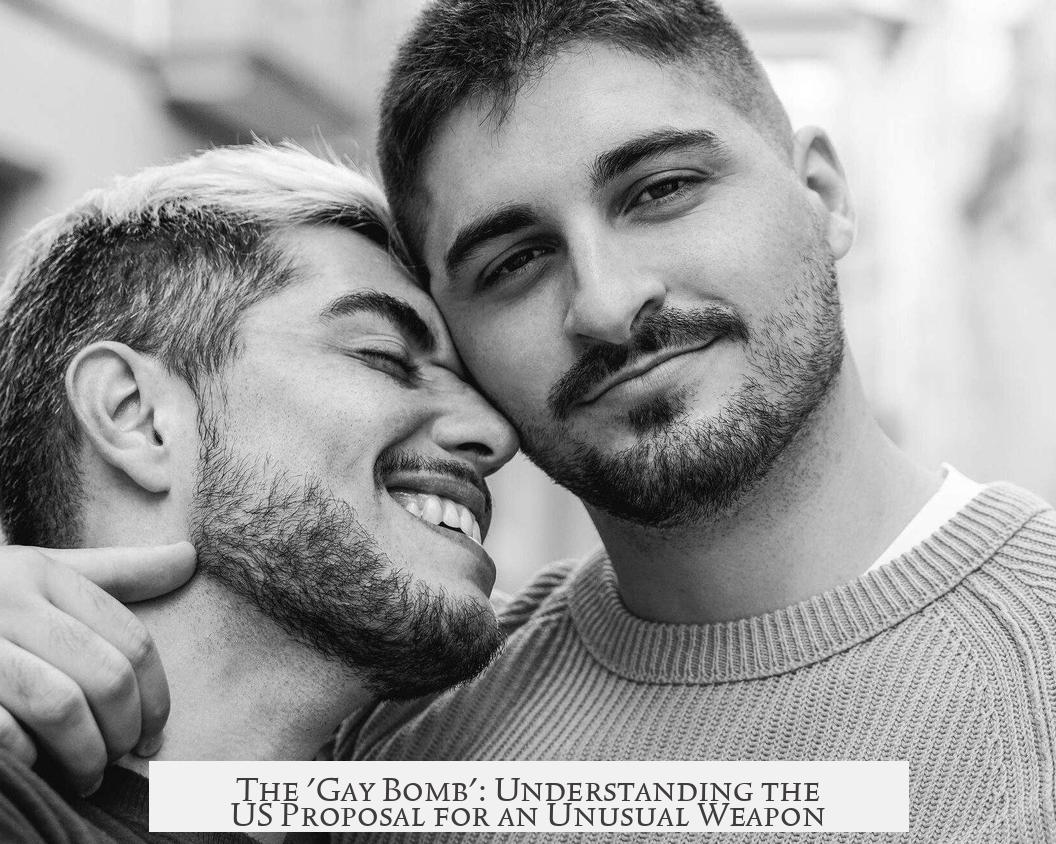The ‘Gay Bomb’ was a speculative chemical weapon concept proposed by the US military that aimed to disrupt enemy troops by making them attracted to each other sexually. It existed only as a brief idea in early brainstorming documents and was never developed or tested.

The proposal appeared as a single line in a 1990s military research document exploring non-lethal chemical weapons. Its goal was to release a chemical agent causing same-sex attraction among enemy forces to break unit cohesion and lower morale. Alongside this idea, the document listed other theoretical chemical agents, such as ones increasing sensitivity to sunlight.
This concept never passed beyond the proposal stage. It was one among many unusual or impractical weapons considered during that period, including the so-called “Vampire Bomb” or pigeon-guided bombs. These ideas reflected the search for novel, non-lethal methods to incapacitate opponents without traditional violence.

Public and media attention focused on the ‘Gay Bomb’ because of its absurd premise. It quickly became a symbol of bizarre military brainstorming. Despite this, more outlandish weapon proposals existed and advanced further before cancellation. The idea resurfaced through various popular culture references, including television satire, which helped cement its reputation as a strange footnote in military history.
| Aspect | Details |
|---|---|
| Origin | Single line in 1990s US military chemical weapons proposal |
| Purpose | Chemical to induce sexual attraction among enemy soldiers |
| Development status | Never advanced beyond brainstorming stage |
| Other proposals | Sensitivity to sunlight chemicals, pigeon-guided bombs |
| Public reaction | Ridiculed and became popular culture reference |
The original proposal is found in section 4.3 of the official document, archived at this link. The fact it remains a single line amidst a list of ideas highlights its speculative nature rather than a serious weapon development program.

- The ‘Gay Bomb’ aimed to disrupt troops by inducing attraction between soldiers.
- It was a brief concept, never developed or tested.
- Other equally unusual ideas existed concurrently.
- Public mainly learns about it due to its oddity and cultural references.
What Exactly Was the ‘Gay Bomb’ and Why Did the US Plan to Develop It?
At its core, the ‘Gay Bomb’ was a quirky, one-line idea tossed into early military brainstorming documents. It never graduated beyond the drawing board but captured public imagination because, frankly, it sounds like something out of a sci-fi comedy.

So, what was this so-called ‘Gay Bomb’? Let’s dig into the facts and unravel this odd piece of military lore.
A Peculiar Proposal Among Many

The ‘Gay Bomb’ wasn’t an official, fully fleshed-out weapon concept. Instead, it was one brief mention in an exploratory list of chemical weapon ideas. Imagine a brainstorming session where someone throws out a wild idea, jots it down on a napkin, and moves on. That’s pretty much it.
In fact, the original proposal showed up in official documents—specifically section 4.3 of a 1994 Air Force report, now archived online. The line suggested developing a chemical agent that could induce strong sexual attraction between enemy soldiers. The goal? Cause quite the distraction, disrupt unit cohesion, and potentially lower battlefield effectiveness.

Alongside this almost too-bizarre-to-be-true concept, the documents also mention other strange ideas. For example, there was talk about chemicals that would make personnel overly sensitive to sunlight—lovingly dubbed the “Vampire Bomb.” Although less catchy, it was part of the same creative brainstorming effort.
Why Even Consider Such a Weapon?

It might sound absurd, but the military historically explored many unconventional ideas as non-lethal or incapacitating weapons. The reasoning was strategic: disarm the enemy without outright killing or causing lasting harm.
Imagine facing an enemy suddenly distracted by uncontrollable feelings or adversely affected by a chemical that makes spending daylight impossible. The objective was to incapacitate without destruction—turn the battlefield into a confusing, unmanageable zone for adversaries.
Of course, the practicality and ethical implications of a ‘Gay Bomb’ were never seriously evaluated, mainly because the idea didn’t move beyond casual discussion.
How Did the Public React? A Mix of Humor and Bewilderment
Once details about the ‘Gay Bomb’ leaked, the internet had a field day. The military’s suggestion to weaponize attraction struck many as hilarious and frankly ridiculous. It became fodder for jokes and late-night comedy sketches, like the one on “30 Rock,” which captured the absurdity perfectly.
Yet, it’s important to note that even wilder proposals had existed. The military once considered pigeon-guided bombs—yep, pigeons trained to drop explosives—and flamethrowers on ships designed explicitly to incinerate enemy planes. So by comparison, the ‘Gay Bomb’ doesn’t seem *that* crazy.
The Documentation: Where It All Started
The germ of the ‘Gay Bomb’ idea is in a USAF Wright Laboratory report titled “New and Novel Chemical-Biological Incident Countermeasures” from 1994. The proposal is listed as an example of potential non-lethal chemical agents in a section about incapacitating enemy forces.
For those curious, the original passage appears at section 4.3: Read the document here (archived)
This tiny mention was quickly overshadowed by more pressing military R&D priorities, and no budget, research, or testing ever followed.
What Can We Learn From the ‘Gay Bomb’ Episode?
First, the ‘Gay Bomb’ serves as an excellent reminder that military research isn’t always about smart, practical designs. Some ideas are wild experiments or thought exercises meant to explore “what if” scenarios. These brainstorming moments don’t always result in usable weapons—sometimes they’re just a product of creative thinking gone, well, a bit off the rails.
Second, it highlights how public perception shapes the narrative. The ‘Gay Bomb’ became more famous for its name and concept’s absurdity than any technical merit. It transformed military innovation into pop culture fodder and satire, reminding us that sometimes bureaucracy’s weird ideas are best left on paper.
Lastly, it shows the military’s interest in non-lethal weapons isn’t a recent thing. The quest to disable rather than kill has driven decades of experiments—from agents affecting behavior to those causing physical discomfort without long-term harm.
So, Did the US Ever Seriously Pursue the ‘Gay Bomb’?
Nope. Despite the buzz, it’s clear the proposal was more speculative than actionable. Unlike conventional weapons systems with prototypes and trials, the ‘Gay Bomb’ remained a single line in a list of odd concepts. No funding, no development, no deployment—just a quirky footnote in military history.
But the mere fact that it appeared at all reflects a certain creative ambition—and, frankly, a sense of humor—in military planning. Wanting to incapacitate an enemy without outright violence? That’s innovative. But turning attraction into a weapon? Now that’s unusual.
The Takeaway: A ‘Bomb’ More Fitting for Comedy Than Combat
In the end, the ‘Gay Bomb’ is less a secret weapon and more a symbol. It reminds us that outside the high-tech missiles and stealth planes lies a world of far-fetched ideas. Some make sense, others don’t, and a few make us laugh (or cringe).
Next time someone mentions bizarre weapons, remember the one that tried to weaponize love—or at least, distraction. The ‘Gay Bomb’ never blew anything up, but it sure exploded in popular culture.
Would you find a weapon like this clever or just plain silly? And what other odd military ideas would you love to learn about? Share your thoughts!




